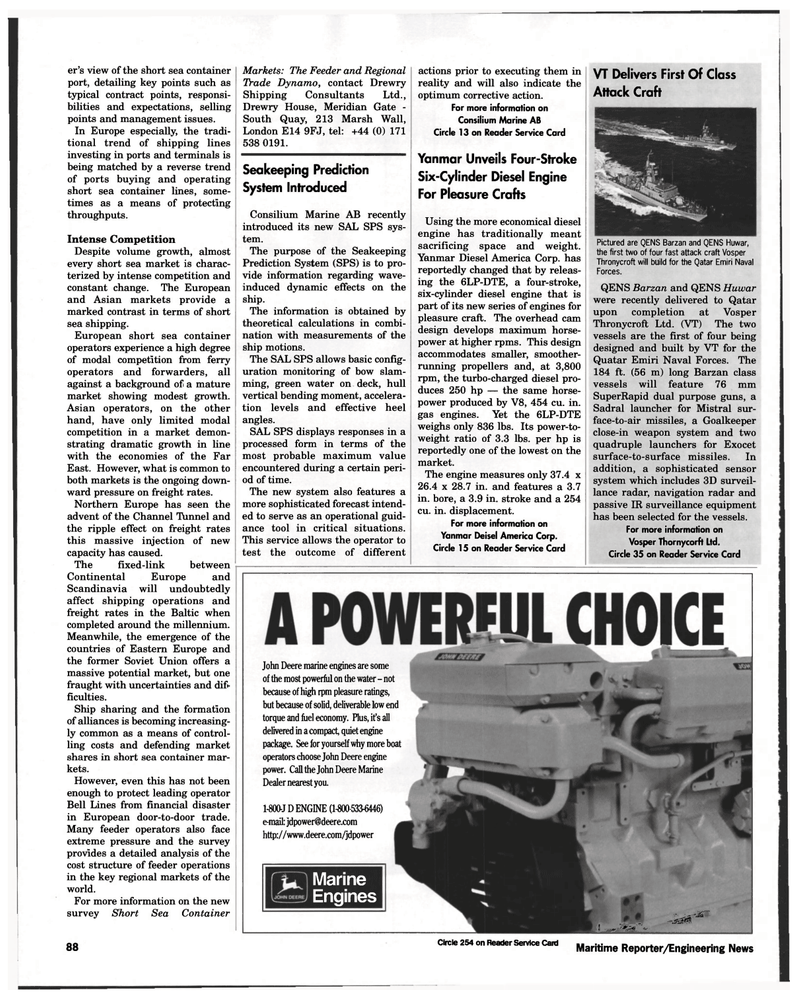
Page 78: of Maritime Reporter Magazine (October 1997)
Read this page in Pdf, Flash or Html5 edition of October 1997 Maritime Reporter Magazine
er's view of the short sea container port, detailing key points such as typical contract points, responsi- bilities and expectations, selling points and management issues.
In Europe especially, the tradi- tional trend of shipping lines investing in ports and terminals is being matched by a reverse trend of ports buying and operating short sea container lines, some- times as a means of protecting throughputs.
Intense Competition
Despite volume growth, almost every short sea market is charac- terized by intense competition and constant change. The European and Asian markets provide a marked contrast in terms of short sea shipping.
European short sea container operators experience a high degree of modal competition from ferry operators and forwarders, all against a background of a mature market showing modest growth.
Asian operators, on the other hand, have only limited modal competition in a market demon- strating dramatic growth in line with the economies of the Far
East. However, what is common to both markets is the ongoing down- ward pressure on freight rates.
Northern Europe has seen the advent of the Channel Tunnel and the ripple effect on freight rates this massive injection of new capacity has caused.
The fixed-link between
Continental Europe and
Scandinavia will undoubtedly affect shipping operations and freight rates in the Baltic when completed around the millennium.
Meanwhile, the emergence of the countries of Eastern Europe and the former Soviet Union offers a massive potential market, but one fraught with uncertainties and dif- ficulties.
Ship sharing and the formation of alliances is becoming increasing- ly common as a means of control- ling costs and defending market shares in short sea container mar- kets.
However, even this has not been enough to protect leading operator
Bell Lines from financial disaster in European door-to-door trade.
Many feeder operators also face extreme pressure and the survey provides a detailed analysis of the cost structure of feeder operations in the key regional markets of the world.
For more information on the new survey Short Sea Container
Markets: The Feeder and Regional
Trade Dynamo, contact Drewry
Shipping Consultants Ltd.,
Drewry House, Meridian Gate -
South Quay, 213 Marsh Wall,
London E14 9FJ, tel: +44 (0) 171 538 0191.
Seakeeping Prediction
System Introduced
Consilium Marine AB recently introduced its new SAL SPS sys- tem.
The purpose of the Seakeeping
Prediction System (SPS) is to pro- vide information regarding wave- induced dynamic effects on the ship.
The information is obtained by theoretical calculations in combi- nation with measurements of the ship motions.
The SAL SPS allows basic config- uration monitoring of bow slam- ming, green water on deck, hull vertical bending moment, accelera- tion levels and effective heel angles.
SAL SPS displays responses in a processed form in terms of the most probable maximum value encountered during a certain peri- od of time.
The new system also features a more sophisticated forecast intend- ed to serve as an operational guid- ance tool in critical situations.
This service allows the operator to test the outcome of different actions prior to executing them in reality and will also indicate the optimum corrective action.
For more information on
Consilium Marine AB
Circle 13 on Reader Service Card
Yanmar Unveils Four-Stroke
Six-Cylinder Diesel Engine
For Pleasure Crafts
Using the more economical diesel engine has traditionally meant sacrificing space and weight.
Yanmar Diesel America Corp. has reportedly changed that by releas- ing the 6LP-DTE, a four-stroke, six-cylinder diesel engine that is part of its new series of engines for pleasure craft. The overhead cam design develops maximum horse- power at higher rpms. This design accommodates smaller, smoother- running propellers and, at 3,800 rpm, the turbo-charged diesel pro- duces 250 hp — the same horse- power produced by V8, 454 cu. in. gas engines. Yet the 6LP-DTE weighs only 836 lbs. Its power-to- weight ratio of 3.3 lbs. per hp is reportedly one of the lowest on the market.
The engine measures only 37.4 x 26.4 x 28.7 in. and features a 3.7 in. bore, a 3.9 in. stroke and a 254 cu. in. displacement.
For more information on
Yanmar Deisel America Corp.
Circle 15 on Reader Service Card
VT Delivers First Of Class
Attack Craft
Pictured are QENS Barzan and QENS Huwar, the first two of four fast attack craft Vosper
Thronycroft will build for the Qatar Emiri Naval
Forces.
QENS Barzan and QENS Huwar were recently delivered to Qatar upon completion at Vosper
Thronycroft Ltd. (VT) The two vessels are the first of four being designed and built by VT for the
Quatar Emiri Naval Forces. The 184 ft. (56 m) long Barzan class vessels will feature 76 mm
SuperRapid dual purpose guns, a
Sadral launcher for Mistral sur- face-to-air missiles, a Goalkeeper close-in weapon system and two quadruple launchers for Exocet surface-to-surface missiles. In addition, a sophisticated sensor system which includes 3D surveil- lance radar, navigation radar and passive IR surveillance equipment has been selected for the vessels.
For more information on
Vosper Thornycorft Ltd.
Circle 35 on Reader Service Card 88
Marine
Engines
John Deere marine engines are some of the most powerful on the water - not because of high rpm pleasure ratings, but because of solid, deliverable low end torque and fuel economy. Plus, if s all delivered in a compact, quiet engine package. See for yourself why more boat operators choose John Deere engine power. Call the John Deere Marine
Dealer nearest you. 1-800-J D ENGINE (1-800-533^446) e-mail: [email protected] http://www.deere.com/jdpower „ * * [ ^atmWr^-*"
Circle 254 on Reader Service Card Maritime Reporter/Engineering News

 77
77

 79
79
